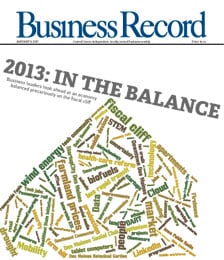Casey’s profits plummet

Casey’s General Stores Inc. Chief Financial Officer and Vice President Jim Shaffer called the three months ended April 30 his “biggest disappointment for a quarter” as the company’s profits plummeted 85 percent, despite a sales increase of 10.6 percent.
The Ankeny-based convenience store chain’s net income in the fiscal fourth quarter fell to $838,000, or 2 cents per share, from $5.6 million, or 11 cents per share, in the year-ago period, largely due to higher gasoline prices and workers’ compensation costs, Ronald Lamb, Casey’s chairman and CEO, said in a press release Thursday.
Itemizing the earnings shortfalls, Lamb estimated that the $3.4 million increase in insurance reserves, primarily for workers’ compensation, cost the company 4 cents per share. This increase was the result of an independent actuarial review completed this quarter. Lamb said the review, a first for Casey’s, was in response to the size of the reserves and recent changes in the retentions.
“It’s the first time we have had an actuarial opinion on the reserves and it will be an annual event now,” Shaffer said. “We did not expect to increase our operating expenses by $3.4 million, but we see it as a one-time adjustment.”
Lamb said another significant factor was a lower profit margin on gasoline sales, which cost the company 3 cents per share even though gasoline sales were up 5.4 percent. The average margin was 9.5 cents per gallon, compared with 10.4 cents per gallon this time last year. Lamb said Casey’s cost per gallon has risen every week since December, a trend that hasn’t been seen since the 1970s.
“Rising gas prices are usually the environment when our margins are lowest,” Shaffer said. “We’ve had an unusual period. I think we had about 26 weeks where it seemed like the cost was just going up, which is the worst gasoline environment for a retailer.”
Also, a decrease in the stores’ profit margin on cigarette sales accounted for a 3 cent per share loss and higher cheese prices accounted for 1 cent, Lamb said. Higher property taxes and significantly higher bank fees caused by increased credit card usage also proved to be a drag on earnings.
A strength of the fourth quarter was inside sales, specifically of prepared food and fountain drinks, which improved 12.2 percent. Shaffer said inside sales figures were watched closely, since high gas prices historically affect customers’ other purchases.
Another sign of company growth, Lamb said, is its acquisition of 26 stores and construction of 15 new ones during the most recent fiscal year. Lamb said Casey’s plans to be more aggressive during fiscal 2005, acquiring at least 43 stores and building 15 more. Shaffer said acquisitions will be a major focus of the company’s growth strategy.
“We have a strong cash flow and a strong balance sheet,” Shaffer said. “We’re well positioned financially to do some acquisitions and we’ve done pretty well with that over the last few years.”
In his projections about the future, Lamb was optimistic, forecasting that the company’s new satellite-based gasoline inventory system will add efficiencies and that wholesale prices will begin to normalize.






